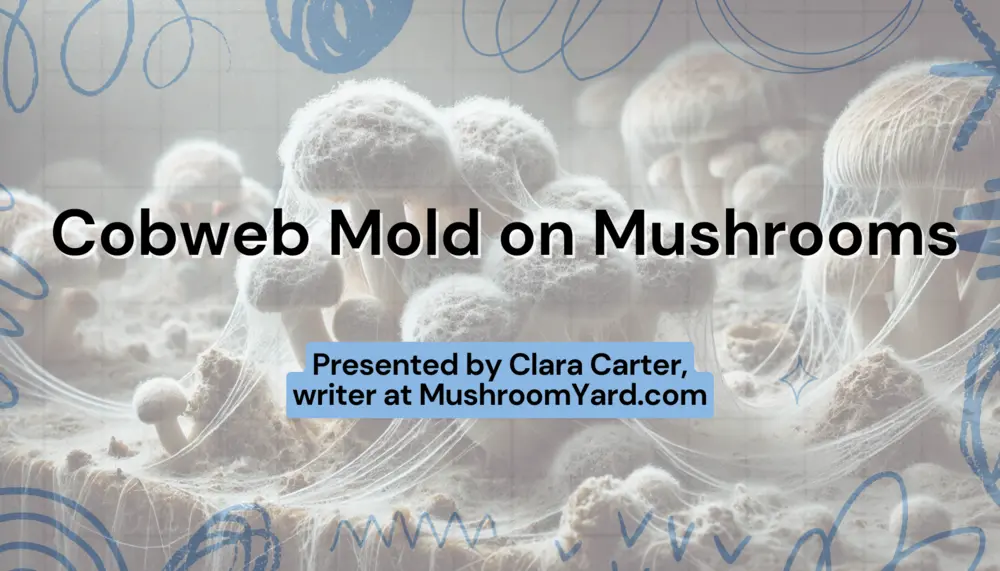

Cobweb mold is one of the most common issues faced by mushroom growers, often appearing unexpectedly and spreading at an alarming pace. This fuzzy, web-like mold can take over a substrate quickly, posing a serious threat to mushroom crops if not addressed early. Its rapid expansion is a headache for growers, especially since it often gets mistaken for healthy mushroom mycelium during its early stages.
Recognize and manage cobweb mold if you really want to avoid major crop loss. In this article, I will guide you on how to correctly identify cobweb mold, prevent its growth, and apply effective treatments to keep your mushrooms safe.
Cobweb mold is a type of fungal contamination that typically targets mushroom substrates, threatening the health and growth of your mushrooms. It’s known for its light, wispy texture that spreads rapidly, often forming a thin, web-like layer over the surface. One of the most common species causing this issue is Dactylium dendroides, though other related fungi can also trigger similar outbreaks.
This mold tends to develop in environments with high humidity and inadequate airflow, making it a frequent problem in poorly ventilated grow rooms. Its appearance starts as a white, fuzzy growth, but if left untreated, it may turn gray or even darker, covering not just the substrate but sometimes the mushrooms themselves.
By recognizing its early signs, growers can take quick action to prevent it from overwhelming the crop.
At first glance, cobweb mold and mycelium can look similar, but there are key differences:
For a deeper dive into these differences, stay tuned for a detailed comparison in an upcoming article!
Till then you can check my previous article on Mold vs Mycelium
Cobweb mold poses a serious threat to mushroom cultivation by competing with mycelium for vital nutrients, ultimately stifling healthy growth. As it spreads across the substrate, it can suffocate the developing mushrooms, halting their progress. In a matter of days, cobweb mold can overtake a batch, leaving mushrooms weakened or unable to grow altogether.
Beyond damaging individual crops, cobweb mold has the potential to spread throughout the entire grow room. Its spores can easily contaminate other substrates, leading to widespread infestations and ruining multiple batches if not controlled swiftly.
Several factors contribute to the development of cobweb mold in mushroom cultivation:
Preventing cobweb mold in mushroom cultivation involves maintaining the right environment and following strict hygiene practices. Good ventilation is essential, as consistent airflow helps to prevent mold spores from settling and spreading across the substrate. Equally important is sterilizing all tools, substrates, and grow spaces before starting a new batch, reducing the risk of contamination.
Keeping humidity levels under control is another key factor; overly damp conditions can create a breeding ground for mold. Monitoring the temperature is also important, as warmer environments can accelerate mold growth. Finally, practicing clean handling by wearing clean clothing, washing hands, and using disinfectants when working with mushrooms can significantly lower the chances of introducing harmful spores.
I will cover the most effective methods to control and remove cobweb mold from your mushroom cultivation setup.
If you want more in-depth article on this check: How to Get Rid of Cobweb Mold on Mycelium
One of the most efficient ways to combat cobweb mold is by using hydrogen peroxide. A diluted 3% solution can be sprayed directly onto the mold. The hydrogen peroxide works by killing the mold on contact, without harming your mushrooms or mycelium.
How to use it:
Another effective method is creating a salt paste. Salt works by drawing moisture out of the mold, dehydrating it and halting its spread.
How to use it:
Cobweb mold thrives in humid, stagnant environments. Improving airflow in your grow space helps reduce the conditions in which it flourishes.
Tips for increasing FAE:
If an area of your substrate is heavily contaminated with cobweb mold, removing it may be the best option to prevent the spread of spores.
Steps for safe disposal: